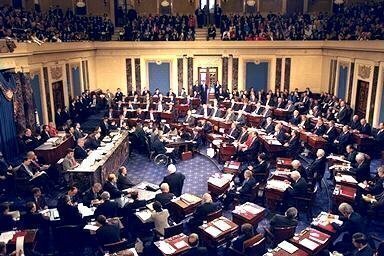On Wednesday afternoon, Justice Anthony Kennedy announced his retirement from the Supreme Court. So what happens next in the process to choose his replacement?
 Under Article II, Clause 2, of the Constitution, the nomination process starts with a public announcement by President Donald Trump about his selection to replace Kennedy. In the past when Justices have retired at the end of a term, the President has nominated a replacement during the summer.
Under Article II, Clause 2, of the Constitution, the nomination process starts with a public announcement by President Donald Trump about his selection to replace Kennedy. In the past when Justices have retired at the end of a term, the President has nominated a replacement during the summer.
Depending on the timing of a Justice’s announcement, such end-of-term nominations have been made, in most cases, between May and August since 1981, when President Ronald Reagan named Sandra Day O’Connor to replace Potter Stewart.
Link: List of Supreme Court nomination dates since 1789
In recent years, the average Supreme Court nomination and confirmation process has taken between two and three months. (One exception was Merrick Garland’s failed nomination.) The new Justice, if confirmed, could be available for arguments heard at the Court when the Justices resume business on the first Monday in October.
Once President Trump selects a nominee, he will officially notify the Senate of his nomination in a written statement. This is required under the Constitution’s “Appointments Clause” in Article II, Section 2, Clause 2, which reads that the President “shall nominate, and by and with the Advice and Consent of the Senate, shall appoint … Judges of the supreme Court.”
Under Senate standing rules going back to 1868, the nomination is sent to the Senate Judiciary Committee, unless the nominee is a current or former Senate member. The Senate Judiciary chair, Charles Grassley, will authorize a pre-hearing investigative stage about the nominee, followed by public hearings at the Judiciary Committee and a decision on a recommendation to the full Senate.
The nominee also undergoes the extensive investigation process. The American Bar Association will issue a rating for the nominee based on professional qualifications. And traditionally, the nominee will meet with Senators who are part of the approval process.
Next, the nominee appears at a public hearing at the Senate, facing a variety of questions from the Judiciary Committee. By a majority vote, the Judiciary Committee can report the nomination favorably, report it unfavorably, or report it without making any recommendation at all. It is also possible for the committee to take no action of any type to send a report to the full Senate.
Once a recommendation vote is taken by the Judiciary Committee, and the nomination is sent to the entire Senate for a floor vote, a simple Senate majority is needed to confirm the nominee. The filibuster for the Supreme Court nominations was eliminated by the current Senate.
The Republicans have 51 seats in the current Senate, which leaves little margin for error in the confirmation process. And with mid-term elections in November, there is a high likelihood that the President and the GOP leadership will keep the nomination process on a timely schedule.
Scott Bomboy is the editor in chief of the National Constitution Center.







